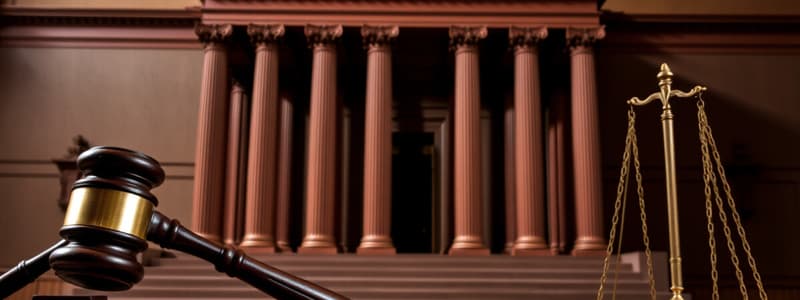Podcast
Questions and Answers
What is the primary function of an Appellate Court?
What is the primary function of an Appellate Court?
- To conduct trials for defendants
- To initiate new criminal cases
- To rehear cases originating from a trial court (correct)
- To impose sentences on convicted offenders
Which of the following best describes Common Law?
Which of the following best describes Common Law?
- A judicial system independent of historical precedents
- A legal framework primarily derived from judicial decisions (correct)
- A system of laws based solely on statutory codes
- A compilation of local government regulations
Which branch of the United States government is responsible for the administration of public affairs?
Which branch of the United States government is responsible for the administration of public affairs?
- Legislative Branch
- Judicial Branch
- Executive Branch (correct)
- Administrative Branch
What does the term 'Due Process' signify in the context of the criminal justice system?
What does the term 'Due Process' signify in the context of the criminal justice system?
What is the significance of the Federal Rules of Criminal Procedure?
What is the significance of the Federal Rules of Criminal Procedure?
Which concept refers to the economic application of resources in the context of the justice system?
Which concept refers to the economic application of resources in the context of the justice system?
In the context of the U.S. legal system, what does Dual Court System refer to?
In the context of the U.S. legal system, what does Dual Court System refer to?
What is the primary focus of the Bureau of Justice Statistics?
What is the primary focus of the Bureau of Justice Statistics?
Which of the following terms best captures the concept of fairness in the justice system?
Which of the following terms best captures the concept of fairness in the justice system?
What defines the Criminal Code within the U.S. legal framework?
What defines the Criminal Code within the U.S. legal framework?
Which stage of the judicial process occurs immediately after a suspect is arrested?
Which stage of the judicial process occurs immediately after a suspect is arrested?
What is the primary focus of an appellate court when reviewing cases?
What is the primary focus of an appellate court when reviewing cases?
What type of information does the Bureau of Justice Statistics primarily collect?
What type of information does the Bureau of Justice Statistics primarily collect?
Which of the following best describes the concept of Dual Federalism?
Which of the following best describes the concept of Dual Federalism?
Which amendment ensures individuals are protected against self-incrimination?
Which amendment ensures individuals are protected against self-incrimination?
What term describes the relationship of laws and regulations collected in a systematic way?
What term describes the relationship of laws and regulations collected in a systematic way?
During which part of a criminal case does a defendant formally enter a plea?
During which part of a criminal case does a defendant formally enter a plea?
Which term best explains the evolution of legal precedents through judicial decisions?
Which term best explains the evolution of legal precedents through judicial decisions?
What is the primary purpose of procedural due process?
What is the primary purpose of procedural due process?
What is the primary goal of the Juvenile Court Movement?
What is the primary goal of the Juvenile Court Movement?
Which principle ensures legal procedures are followed fairly in the judicial process?
Which principle ensures legal procedures are followed fairly in the judicial process?
What does the Nonsystem Argument suggest about the criminal justice system?
What does the Nonsystem Argument suggest about the criminal justice system?
In the context of the judicial system, what does hierarchical structure imply?
In the context of the judicial system, what does hierarchical structure imply?
How does efficiency relate to the criminal justice system?
How does efficiency relate to the criminal justice system?
What role does the Executive Branch play in the criminal justice system?
What role does the Executive Branch play in the criminal justice system?
What is the main focus of juvenile justice as a legal framework?
What is the main focus of juvenile justice as a legal framework?
What does Judicial Review allow courts to do?
What does Judicial Review allow courts to do?
Flashcards are hidden until you start studying
Study Notes
Key Concepts in the Justice System
- Appellate Court: A court with the authority to review and rehear cases from a trial court, ensuring legal correctness in lower court rulings.
- Bureau of Justice Statistics (BJS): An agency focused on collecting, analyzing, and disseminating data on crime, offenders, victims, and the operation of justice systems at all government levels.
- Code: A structured compilation of laws organized by subject matter to provide clarity and accessibility in legal frameworks.
- Common Law: A legal system originating from England, now prevalent in the U.S., which relies heavily on court decisions and precedents rather than solely on statutes.
Government Structure
- Congress of the United States: The legislative branch comprising the U.S. House of Representatives and the U.S. Senate, responsible for enacting laws.
- Constitution: A foundational document outlining fundamental principles that govern a nation or state, serving as the supreme law.
- Criminal Code: A section of either the U.S. Code or individual state codes specifically addressing laws related to criminal offenses.
Judicial Authority and Processes
- Decisions (courts): Written opinions from appellate courts that carry legal weight, shaping common law through judicial interpretation.
- Dual Court System: Describes the U.S. structure which includes both state and federal courts, allowing for a diverse judicial landscape.
- Dual Federalism: A governance model where powers are divided between national and state governments, with distinct roles and responsibilities.
Rights and Legal Framework
- Due Process: A constitutional guarantee ensuring defendants receive fair treatment and access to justice within the criminal system.
- Effectiveness: The capacity of the justice system to fulfill its duties fairly, considering equity, constitutional rights, and public safety.
- Efficiency: The judicious use of resources to achieve legal objectives and enhance public safety in criminal justice operations.
Governance and Fair Justice
- Executive Branch: Responsible for administering public policies and enforcing laws, playing a crucial role in the overall governance structure.
- Fairness: A principle emphasizing equal treatment of similar offenders, ensuring that sentencing considers all legally relevant factors consistently.
- Federal Rules of Criminal Procedure: Regulations established by the Supreme Court of the United States that dictate the conduct of federal criminal prosecutions.
Judicial Process
- Criminal cases progress through distinct stages: arrest, charging, initial appearance, preliminary hearing, arraignment, trial, sentencing, and appeals.
Crime Prevention Strategies
- Utilizes community policing, social programs, and educational initiatives aiming to prevent criminal behavior before it occurs.
Appellate Court
- Reviews rulings from lower courts, focusing on legal errors rather than factual disputes without introducing new evidence.
Bureau of Justice Statistics
- A key source for statistical data on crime and the justice system, involved in gathering, analyzing, and distributing crime-related information.
Code
- Systematic compilation of laws and regulations, exemplified by the Penal Code and Criminal Code that outline crimes and corresponding penalties.
Common Law
- A body of unwritten law derived from court judgments and customs, evolving through judicial decisions to create legal precedents.
Congress of the United States
- The federal body that shapes criminal justice laws, influencing policy and funding through legislative actions.
Constitution
- The foundational legal document of the U.S., detailing individual rights and the structure of government, with amendments protecting justice system integrity.
Criminal Code
- Encompasses specific statutes that delineate criminal offenses and penalties under both federal and state law.
Decisions (courts)
- Judicial determinations that interpret legislation, establish legal precedents, and affect case outcomes, influencing future legal interpretations.
Dual Court System
- Consists of separate federal and state court systems, each with distinct jurisdictions and operational procedures.
Dual Federalism
- A governance concept where state and federal bodies operate independently within their respective domains of authority.
Due Process
- Legal safeguard ensuring fair treatment within the judicial framework, covering rights to a fair trial, representation, and protection from self-incrimination.
Effectiveness
- Evaluates how successfully the criminal justice system meets objectives, particularly in crime reduction and offender rehabilitation.
Efficiency
- Relates to the optimal use of resources in the criminal justice system to achieve goals without incurring unnecessary expenditures.
Executive Branch
- The governmental branch responsible for law enforcement and overseeing the criminal justice system, including agencies such as the Department of Justice.
Fairness
- The principle of administering justice impartially and without bias, crucial for maintaining public trust in the justice system.
Federal Rules of Criminal Procedure
- Guidelines governing federal criminal trial procedures, including processes for indictment, arraignment, and trial.
Hierarchical
- Illustrates the judicial system's structure in which higher courts have the authority to review and potentially overturn lower court decisions.
Infancy Defense
- A legal argument allowing minors to avoid criminal liability due to their age and insufficient understanding of their wrongdoing.
Judicial Review
- Courts' authority to assess the constitutionality of legislative and executive actions, vital for maintaining government checks and balances.
Judiciary
- The branch responsible for law interpretation and justice administration, encompassing various court levels from local to supreme courts.
Juvenile Court Movement
- Initiated in the late 19th century, emphasizing rehabilitation for juvenile offenders over punishment, fostering a supportive environment for youth.
Juvenile Justice
- The legal framework addressing offenses committed by minors, focusing on rehabilitation and their reintegration into society.
Legislature
- The governmental body that enacts criminal laws and policies at both federal and state levels, influencing crime rates and law enforcement.
Nonsystem Argument
- Asserts that the criminal justice system operates disjointedly, lacking cohesion among its various components.
Penal Code
- A legislative collection of laws specifying criminal offenses and their associated penalties, which can differ between jurisdictions.
Plea Bargain
- A negotiation allowing defendants to plead guilty to lesser charges in exchange for reduced sentences, alleviating case backlogs.
Procedural Due Process
- Guarantees adherence to fair procedures in legal proceedings, protecting individuals against arbitrary infringement of life, liberty, or property.
System
- Refers to the collective structure of institutions, laws, and processes that govern and execute criminal justice.
Three Branches of Government
- Comprises Legislative (creates laws), Executive (enforces laws), and Judicial (interprets laws) branches, each with distinct responsibilities to ensure governance balance.
Studying That Suits You
Use AI to generate personalized quizzes and flashcards to suit your learning preferences.




